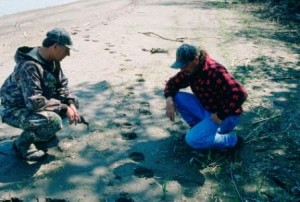Part Two: Identifying Big Bear Sign
First keep in mind that nearly all book bears are males, and these big boars don’t advertise their presence in a manner that smaller boars, yearlings and sows with cubs so often do. So, you’ll want to examine the bait site carefully and weigh all the “soft” evidence before you make any decisions as to the size, age and sex of those bruins in attendance.
Start by looking for bear tracks in the nearby mud, sand or soft earth. They are hard to find, but a front pad better than five inches in width is usually a very good bear (The rear pad resembles a barefoot person). Creek beds, logging roads, gravel bars and beaver dams are all good places to look for tracks. Keep in mind that large bears rarely approach a bait station on a daily basis, while subordinate bears will feed here almost daily. Indeed, those “old” tracks you found on the beaver dam might in fact be heralding a return visit by that bruin in a day or two.

A bear's spoor is a dead give away as to his age and probable size.
You should have no trouble locating entrance and exit trails if the bait is being hit regularly. If so, examine nearby trees for more bear sign. Claw marks spaced high up the trunk will give you clues as to how tall the bear is, and the space between individual clawings can give you a sense of how wide his front pads might be. Fresh beds on the trail or near the bait site can also indicate relative body size. Be aware that bears will often sit on their haunches, like a dog, leaving smaller “beds” than if they were lying on their belly. Finally, if the nearby brush is thick, look for bear “tunnels” hollowed out of the branches and leaves, and bear fur stuck to those branches. This is an excellent way to determine the color(s) of the bear(s) feeding here.
Of course, seeing a big bear within a half-mile of any bait station is a good sign, even if that particular bait has not yet been hit. Sooner or later that bear will sniff out your pile of goodies, and sneak in to check it out. When he does, he may not leave any obvious clues behind, such as tracks or claw marks, and he may or may not sample the food.
He will often however first circle the bait, staying under cover and just within sight of your offering. You will have to look closely, maybe even get on your hands and knees, as the trail will be faint. Look for wide pad impressions in the dead leaves, crushed vegetation and bear hair stuck in the bark of nearby tree trunks. You may also find logs ripped apart, overturned stones and ankle-high vegetation ripped out of the ground all along this trail, indicating the bear was feeding as he was watching. You may even find where he sat down on his haunches like a dog or laid down on his belly facing the bait as if he was carefully studying the set-up (he was!).
This trail is undoubtedly one of the surest signs you have a big bear working the area, and one of the most overlooked pieces of big-bear evidence available. Locating it usually separates the casual bear hunter from the real expert.

A trophy bruin will often circle a food source before committing himself. Stay alert!
Once you have a trophy boar visiting more or less regularly, you will notice that unlike sows, cubs and yearlings he will put his feet down in the same spot each time he visits. This is one reason why big boars are so easy to snare. Indeed, after a dozen or so visits you might see a faint trail of pie-plate size circles of cleared soil leading to and from the bait. This is a good indication the bruin is sneaking in slowly and very carefully, one outstretched paw at a time.
He will also step over any obstacle in the trail during his final approach such as a dead log or pile of debris very stealthily, electing to put his pad down just on the far side. Sows, cubs and yearlings on the other hand seem to rush right into a bait site, over stepping any obstacle by several inches.
Another clue you have a dominate bear sniffing around is when you stumble upon several large piles of fresh dung one and a half to two inches in diameter scattered around the bait site. I’ve found THE stand when scat such as this seems to be placed purposely on entrance and exit trails. Any droppings the size of a soft drink can usually indicate a very big boar has taken over the bait site, claiming it as his own so to speak, with his own specially scented territorial marker. My impression is that these strategically deposited droppings also function as a warning sign, telling other male bears to keep out, and if any other boar dares to trespass, he trespasses at great risk.
All else being equal, absence of small bear sign is sometimes a good indication a decent bear is in the area. If you must flip a coin, lean towards bait sites located in clearings adjacent to thick underbrush because these locations provide cover that draws larger bears. Keep in mind that your best chance at a bear will be on the first night you hunt from the stand. Once the bear knows your sneaking around the bait, he’ll be much more difficult to bag.
Check back Wednesday for Part Three!
<script type=”text/javascript”>
var gaJsHost = ((“https:” == document.location.protocol) ? “https://ssl.” : “http://www.”);
document.write(unescape(“%3Cscript src='” + gaJsHost + “google-analytics.com/ga.js’ type=’text/javascript’%3E%3C/script%3E”));
</script>
<script type=”text/javascript”>
try {
var pageTracker = _gat._getTracker(“UA-6149898-8”);
pageTracker._trackPageview();
} catch(err) {}</script>
2,358 total views, no views today





![PredatorCougar_HandleCloseUp_lrz[1] The Piranta-Predator "Cougar" Close Up](http://blog.havalon.com/wp-content/uploads/2009/09/PredatorCougar_HandleCloseUp_lrz13-300x74.jpg)